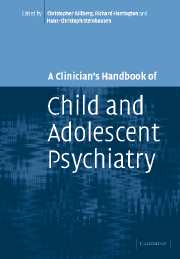Book contents
- Frontmatter
- Contents
- Preface
- List of contributors
- 1 Brain disorders
- 2 Substance use disorders
- 3 Schizophrenia and schizophrenia-like disorders
- 4 Affective disorders
- 5 Anxiety disorders
- 6 Obsessive-compulsive disorders
- 7 Adjustment disorders
- 8 Post-traumatic stress disorder
- 9 Functional somatic symptoms and somatoform disorders in children
- 10 Eating disorders: anorexia nervosa and bulimia nervosa
- 11 Sleep disorders
- 12 Personality disorders
- 13 Mental retardation/learning disability
- 14 Specific developmental disorders of speech and language
- 15 Reading and other learning disorders
- 16 Autism spectrum disorders
- 17 Hyperkinetic disorders
- 18 Conduct disorders
- 19 Elective mutism
- 20 Attachment and disorders of attachment
- 21 Tic disorders
- 22 Elimination disorders: enuresis and encopresis
- 23 Physical and sexual abuse
- 24 Gender identity disorders
- Index
- References
3 - Schizophrenia and schizophrenia-like disorders
Published online by Cambridge University Press: 06 August 2009
- Frontmatter
- Contents
- Preface
- List of contributors
- 1 Brain disorders
- 2 Substance use disorders
- 3 Schizophrenia and schizophrenia-like disorders
- 4 Affective disorders
- 5 Anxiety disorders
- 6 Obsessive-compulsive disorders
- 7 Adjustment disorders
- 8 Post-traumatic stress disorder
- 9 Functional somatic symptoms and somatoform disorders in children
- 10 Eating disorders: anorexia nervosa and bulimia nervosa
- 11 Sleep disorders
- 12 Personality disorders
- 13 Mental retardation/learning disability
- 14 Specific developmental disorders of speech and language
- 15 Reading and other learning disorders
- 16 Autism spectrum disorders
- 17 Hyperkinetic disorders
- 18 Conduct disorders
- 19 Elective mutism
- 20 Attachment and disorders of attachment
- 21 Tic disorders
- 22 Elimination disorders: enuresis and encopresis
- 23 Physical and sexual abuse
- 24 Gender identity disorders
- Index
- References
Summary
Introduction
Approximately 20 per cent of people with a lifetime diagnosis of schizophrenia date the first onset of their psychotic symptoms to before the age of 20 years. One of the key tasks therefore, of the child and adolescent psychiatrist is early recognition and treatment of the disorder notwithstanding its rarity in their overall practice. A much larger number of young people, however, are referred to child and adolescent mental health services with the key question ‘might this young person be developing or suffering from the early stages of schizophrenia or some other psychotic disorder?’. The clinician must also therefore, possess expert knowledge of both its typical and atypical presentations and its differential diagnoses.
Other psychotic disorders presenting during adolescence (and more rarely during childhood) are those of acute or transient psychotic disorders not lasting long enough for a diagnosis of schizophrenia, schizoaffective disorders, delusional disorders, psychotic episodes occurring as part of an underlying affective disorder and psychotic disorders secondary to substance misuse or to general medical conditions.
In many instances the clinician will be able to arrive at a clear formulation and diagnostic understanding and to develop a specific treatment plan. In others, however, diagnostic uncertainty will remain despite a full and careful assessment, even one lasting over a period of weeks. In these cases it is important that the clinician is able to tolerate this uncertainty whilst continuing to take a problem-focused approach to the young person's difficulties.
- Type
- Chapter
- Information
- A Clinician's Handbook of Child and Adolescent Psychiatry , pp. 79 - 109Publisher: Cambridge University PressPrint publication year: 2006
References
- 2
- Cited by



